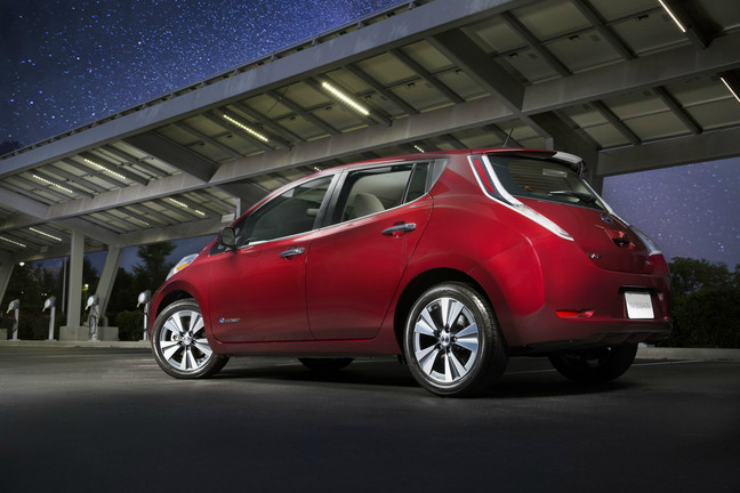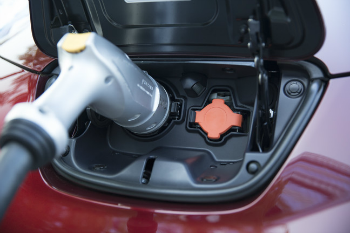Will a green car world really blow away carbon emissions?

Right now, driving your plug-in electric Nissan Leaf in the United States is better for the environment than driving a new gas-powered vehicle, even in regions where that electricity fueling that electric car is being produced by dirty power.
But it’s going to be awhile before electric vehicles replace enough gas-powered cars on the road to make any tweet-worthy improvements to the air we’re breathing or global warming either.
Running the smug test
It’s easy to feel smug in your non-emitting EV, flying down the road past the gas-guzzling polluters that still dominate the highways. But when looking at total emissions for gas-powered cars vs. electric cars, you have to factor in emissions from the production of electricity that charges your car to truly know just how smug you can feel. Take heart.
“In most regions of the country, PEVs (Plug-In Electric Vehicles) are competitive with the best gasoline vehicles available today and in some regions are much better,” says Marcus Alexander, a principal technical leader and manager of vehicle systems analysis at the Electric Power Research Institute in Palo Alto, California.
In California, for instance, where grid power is cleaner than in many other regions in the country thanks to a lot of hydro power, charging a plug-in electric that achieves a fuel economy equivalent of 112 MPG like the Nissan Leaf instead of filling up a new gas-powered car with gasoline, means you’re emitting one-quarter of greenhouse gas emissions of a gas-powered car, Alexander says.
Electrifying results

And that’s great. But are you making an actual impact on Global Warming today? You don’t get to take credit for improving that quite yet. Given the relatively small number of electric vehicles on the roads today, electric vehicles aren’t making much of a dent in emissions reductions, he says.
“Electrification is not going to be a big contributor to that for a number of years,” Alexander says.
By a number of years, Alexander means 2050.
By 2050 – we’re looking at a 24 percent reduction in greenhouse gasses in a scenario where there is no more vehicle electrification than we have today. That reduction is simply based on policies that require higher fuel efficiencies and other smog-reducing tactics among gas-powered cars, says a study by EPRI and the National Resources Defense Council (Alexander was the lead author, by the way).
But replacing gas-powered cars with electric cars makes a much bigger difference – and should be credited with leading to a 52 percent or more reduction in greenhouse gasses by 2050. And yes, there will be a lot more electric cars on the road by then, if the report’s assumptions are correct. The report assumes widespread electric vehicle adoption – accounting for 53 percent of vehicle miles traveled by 2050.
The trouble with oil
But there’s something big that could certainly change that optimistic EV adoption scenario: a little something called the ridiculously low price of oil.
“The per-mile fuel price for a PEV (plug-in electric vehicle) is generally still cheaper than for a gasoline vehicle, but the reduction in the savings will slow down PEV market growth if they persist long term,” he says.
Translation: Fewer people buy electric cars when gas is cheap – so depending on how long the cost of oil stays low will affect how many electric cars ultimately replace gas-powered, emissions-releasing cars on the road.
So how smug can you feel about driving your electric car?
“It is really difficult for an individual person to make a big difference in these global outcomes or even regional outcomes. But on a per vehicle basis, electric vehicles are much cleaner and they have much lower carbon emissions…” Alexander says. “And another thing, by buying these vehicles, you’re encouraging the market, and demonstrating that people want these vehicles — that’s an important contributor.”
By the numbers: EV snapshot of 2015 and, maybe, 2050
Electric Vehicles’ share of total road miles driven
- 2015: 1%
- 2050 (projected): 53%
Greenhouse gas reductions without vehicle electrification
- 2050 (projected): 24%
Greenhouse gas reductions with base level electric vehicle adoption
- 2050 (projected): 52%
Source: EPRI
About the writer: Lindsay Riddell writes about all things green and she’s not afraid of business or science.
Photos: Nissan
See also: Turn your classic car into a green machine
Plus: Buyers guide for green cars: Eco-wheels for 8 personalities, including yours
